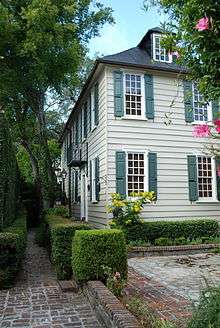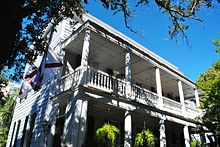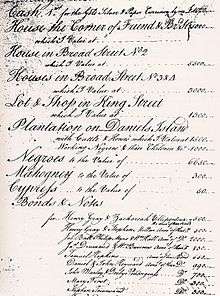Thomas Elfe
Thomas Elfe (1719–1775) was a successful colonial period furniture craftsman in Charleston, South Carolina.
Thomas Elfe | |
|---|---|
 Thomas Elfe House in Charleston, South Carolina | |
| Born | 1719 London, England |
| Died | 28 November 1775 (aged 56) Charleston, South Carolina |
| Occupation | furniture craftsman, cabinetmaker |
Biography
Elfe was born in 1719 in London, England.[1] He was an accomplished and prolific furniture and cabinet craftsman of the American colonial period.[2] Elfe, a contemporary of Thomas Chippendale,[3] was considered Charleston's best furniture craftsman of the eighteenth century.[4] His working career spanned almost thirty years from about 1746 to 1775.[5] At one point in his career his personal worth was a fortune of over 6,200 English pounds.[6] Local Charleston historian and one time director of the Charleston Museum, E. Milby Burton (1889–1977), attributed Elfe as the craftsman of some of the finest nationally acclaimed furniture produced.[7] Burton's research of Charleston furniture craftsmen revealed Elfe as the most successful and famous furniture craftsman in the eighteenth century.[8][9][10]
Elfe immigrated from England in the 1740s and first went to Virginia.[11] From there right around 1746 he moved to Charleston. In 1747 he ran an ad in the South Carolina Gazette for a pair of gilted large carved scones; "To be Raffled for, On Tuesday the 6th of October in the Evening, at the House of Mr. Thomas Blyth in Broad-street a pair of large Gilt Sconces, valued at 150£ Currency. The said Sconces and the Conditions of the Raffle may be seen at Mr. Thomas Elfe's Cabinet-maker, near Doctor Martini's."[5] The £150 value would be several thousand dollars in the twentieth century.[1]
In the mid-eighteenth century "Charles Town" was an economic booming city, the average resident citizens being several times wealthier on the whole than those of New York or Philadelphia. Providing furniture to these wealthy Charlestonians was a lucrative business for the local wood craftsmen and cabinetmakers. The people of Charleston considered themselves as English citizens that just happened to be living in the American colony of South Carolina and did everything possible to follow the footsteps of London society, like acquiring fine furniture.[12] The wealthy Charlestonians loved London style furnishings and would purchase most anything along these fashions that was hand made by local woodworkers. This booming economy made Elfe's woodworking shop successful and profitable. An Elfe's business account book of transactions survives and is held by the Charleston Library Society. This accounting book covering several accounts shows that between 1768 and 1775 Elfe with several employees hand-made over fifteen-hundred furniture pieces including fine detailed cabinets.[9][13] These records show that he sold about seventeen pieces of furniture per month on average.[14]
Elfe's work was influenced by Thomas Chippendale (1718–1779).[11] Their lives had many parallels.[3] Both were born in England at about the same time.[5] Both apprenticed in the 1730s.[15] Elfe apprenticed under his uncle.[1] Chippendale apprenticed under his father.[1] Elfe married in 1748, as did Chippendale, and both were eventually widowed.[1] Both were eventually remarried and had a second wife.[15] Both had a son named Thomas who took over their furniture business.[1] Both lived during the tempestuous times leading to the American Revolution without being personally affected.[15] Both had large furniture shops with many employees.[15] Both died within four years of one another.[15]
Elfe was also a close friend of Charleston joiner and carver Thomas Watson. He learned many of Watson's woodworking skills. When Watson died in 1747, he left Elfe his estate and personal belongings.[1]
Personal life
Elfe was first married to Mary Hancock, a widow, in June 1748.[16] She died a few months later before the year ended. He didn't get married again until the end of 1755, when he married Rachel Prideau. His marriage to Rachel produced several children.[17] Their names were William, Elizabeth, Hannah, George, Thomas, and Benjamin.[1]
Works and locations
Elfe's innovative furniture designs consisted of stacking chests, double chests of drawers, and built-in cabinets. The style types represented Georgian, English Rococo, and Gothic. His furniture also featured Chinese and French styles.[18] Elfe's furniture pieces can be found at South Carolina Governor's Mansion in Columbia. They are also at the Charleston Museum in South Carolina, the DeWitt Wallace Decorative Arts Museum in Virginia, the Museum of Early Southern Decorative Arts in North Carolina, and the Winterthur Museum, Garden and Library in Delaware.[10]
 36 Meeting Street, Charleston. The drawing room mantel is attributed to Thomas Elfe which still exists.[19]
36 Meeting Street, Charleston. The drawing room mantel is attributed to Thomas Elfe which still exists.[19]
Death and Will

Elfe died on 28 November 1775.[5] His will designated his son Thomas, the only cabinetmaker, to receive his business equipment and associated property.[20]
Three Negro cabinet-makers are listed in Elfe's will that he owned as property.[21] Elfe would send his Negro cabinet-makers to various jobs to take down old furniture and set up new furniture or to make minor furniture repairs.[21]
Properties
Elfe was a real estate entrepreneur and made a lot of money buying, selling, and renting properties in the Charleston area. He owned various properties from time to time that he used as his own residence or as a vacation retreat or as a furniture shop. It can not be pinpointed exactly where his major furniture shop was as there were different location descriptions.[22] One description for his furniture shop from the South Carolina Gazette on 28 September 1747 was "near Doct. Martin's" – a location that is not known.[22] Another location for his furniture shop was given in 1748 as "at the corner opposite Mr. Eycott's" – another unknown location.[23]
Elfe owned a property at Broad and Friend (now Legare). He advertised in the South Carolina Gazette in 1766 this property to rent. The ad said the main house was three stories high and each story had three rooms. There was a separate "chair-house" on the property, which was a shop where Elfe built chairs.[22]
A well known property that Elfe designed and built in 1760 as his personal home is at 54 Queen Street in Charleston, South Carolina.[22]
Notes
- Burton, E. Milby (1997). Charleston Furniture, 1700–1825. Univ of South Carolina Press. ISBN 978-1-57003-147-2.CS1 maint: ref=harv (link)
- Charleston Museum (1933). The Charleston Museum Leaflet. Charleston Museum.CS1 maint: ref=harv (link)
- Foster, Mary Preston (2005). Charleston: A Historic Walking Tour. Arcadia Publishing. ISBN 978-0-7385-1779-7.CS1 maint: ref=harv (link)
- Humphrey, Samuel A. (1995). Thomas Elfe, Cabinetmaker. Wyrick. ISBN 978-0-941711-15-9.CS1 maint: ref=harv (link)
- Perry, Lee Davis (2007). Insiders' Guide to Charleston: Including Mt. Pleasant, Summerville, Kiawah, and Other Islands. Globe Pequot Press. ISBN 978-0-7627-4403-9.CS1 maint: ref=harv (link)
- Taunton Press (1995). Fine Woodworking. Taunton Press.CS1 maint: ref=harv (link)
References
- Humphrey 1995, p. 1.
- Perry 2007, p. 143.
- Taunton Press 1995, p. 112.
- Foster 2005, p. 55.
- Burton 1997, p. 84.
- Schwarz, Christopher (2014). "A Visit to Thomas Elfe's House". Popular Woodworking. Retrieved 1 June 2014.
- Humphrey 1995, p. ix "E. Milby Burton (1889–1977), former director of the Charleston Museum, wrote several books and articles calling national attention to the excellence and beauty of Charleston furniture, some of which he attributed to Thomas Elfe".
- Humphrey 1995, p. ix "Burton's research of old research of old records identified many of the Charleston cabinetmakers, pinpointing Elfe as the most admired and respected, and the only one from whose business an account book survives".
- Burton 1997, p. 6 "The account book of Thomas Elfe reveals that during an eight-year period (1768–1775) he made approximately fifteen hundred pieces of furniture. It is not to be supposed that all of the cabinet-makers equaled Elfe either in workmanship or in the quantity of furniture they produced".
- "Eighth Generation". 2014. Retrieved 1 June 2014. "Thomas Elfe was Charleston's most famous and successful cabinetmaker, and his surviving pieces are among the most valuable of American antiques."
- Humphrey 1995, p. 3.
- Burton 1997, p. 14.
- "Thomas Elfe House". Gator Preservationist. 2010. Retrieved 1 June 2014.
- Humphrey 1995, p. ix.
- Humphrey 1995, p. 2.
- St. Philip's Church (Salley, A. S. (Alexander Samuel), 1871–1961, Births, Marriages, Deaths, Charleston, S.C.): Printed for A. S. Salley, jr., by The Walker, Evans & Cogswell Co., retrieved 1 June 2014CS1 maint: multiple names: authors list (link)
- Burton 1997, p. 84,85.
- "Thomas Elfe (1719–1775) Premier Cabinetmaker". INZANOUTS. NedGo, Inc. 2012. Archived from the original on 2 June 2014. Retrieved 1 June 2014.
- "Historical Marker - 36 Meeting Street". Historical Marker Project. 2020. Retrieved 6 January 2020.
- Humphrey 1995, p. 1 "if it is the will and desire of Thomas, that the business be kept for him until he is of age.".
- Burton 1997, p. 11.
- Humphrey 1995, p. 4.
- Charleston Museum 1933, p. 86.